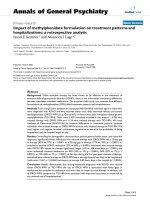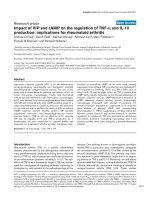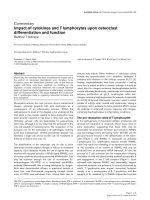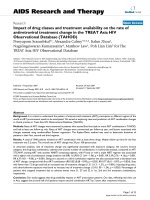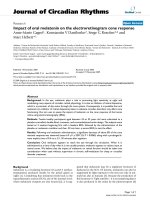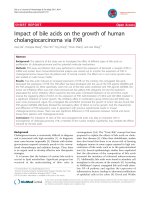Báo cáo y học: "Impact of emergency intubation on central venous oxygen saturation in critically ill patients: a multicenter observational study" potx
Bạn đang xem bản rút gọn của tài liệu. Xem và tải ngay bản đầy đủ của tài liệu tại đây (287.79 KB, 6 trang )
Open Access
Available online />Page 1 of 6
(page number not for citation purposes)
Vol 13 No 3
Research
Impact of emergency intubation on central venous oxygen
saturation in critically ill patients: a multicenter observational
study
Glenn Hernandez
1
, Hector Peña
2
, Rodrigo Cornejo
3
, Maximiliano Rovegno
1
, Jaime Retamal
1
,
Jose Luis Navarro
3
, Ignacio Aranguiz
1
, Ricardo Castro
1
and Alejandro Bruhn
1
1
Pontificia Universidad Católica de Chile, Departamento de Medicina Intensiva, Marcoleta 367, Santiago, Chile
2
Instituto Nacional de Cardiología Ignacio Chávez, UTI de Cardio-Neumología, Juan Badiano No. 1 C.P. 14080, Ciudad de México, México
3
Hospital Clínico Universidad de Chile, Unidad de Pacientes Críticos, Santos Dumont 999, Santiago, Chile
Corresponding author: Glenn Hernandez,
Received: 29 Dec 2008 Revisions requested: 9 Feb 2009 Revisions received: 17 Apr 2009 Accepted: 4 May 2009 Published: 4 May 2009
Critical Care 2009, 13:R63 (doi:10.1186/cc7802)
This article is online at: />© 2009 Hernandez et al.; licensee BioMed Central Ltd.
This is an open access article distributed under the terms of the Creative Commons Attribution License ( />),
which permits unrestricted use, distribution, and reproduction in any medium, provided the original work is properly cited.
Abstract
Introduction Central venous oxygen saturation (ScvO
2
) has
emerged as an important resuscitation goal for critically ill
patients. Nevertheless, growing concerns about its limitations
as a perfusion parameter have been expressed recently,
including the uncommon finding of low ScvO
2
values in patients
in the intensive care unit (ICU). Emergency intubation may
induce strong and eventually divergent effects on the
physiologic determinants of oxygen transport (DO
2
) and oxygen
consumption (VO
2
) and, thus, on ScvO
2
. Therefore, we
conducted a study to determine the impact of emergency
intubation on ScvO
2
.
Methods In this prospective multicenter observational study, we
included 103 septic and non-septic patients with a central
venous catheter in place and in whom emergency intubation
was required. A common intubation protocol was used and we
evaluated several parameters including ScvO
2
before and 15
minutes after emergency intubation. Statistical analysis included
chi-square test and t test.
Results ScvO
2
increased from 61.8 ± 12.6% to 68.9 ± 12.2%,
with no difference between septic and non-septic patients.
ScvO
2
increased in 84 patients (81.6%) without correlation to
changes in arterial oxygen saturation (SaO
2
). Seventy eight
(75.7%) patients were intubated with ScvO
2
less than 70% and
21 (26.9%) normalized the parameter after the intervention.
Only patients with pre-intubation ScvO
2
more than 70% failed to
increase the parameter after intubation.
Conclusions ScvO
2
increases significantly in response to
emergency intubation in the majority of septic and non-septic
patients. When interpreting ScvO
2
during early resuscitation, it
is crucial to consider whether the patient has been recently
intubated or is spontaneously breathing.
Introduction
Central venous oxygen saturation (ScvO
2
), a complex physio-
logic parameter, is being widely used as a resuscitation goal in
critically ill patients [1-3], although several limitations may pre-
clude a clear interpretation of its changes [4]. Early therapeu-
tic interventions applied rather simultaneously after hospital or
intensive care unit (ICU) admission, may affect the oxygen
transport (DO
2
)/oxygen consumption (VO
2
) balance and
ScvO
2
in an unpredictable direction. The uncommon finding of
low ScvO
2
values in critically ill ICU patients may be explained
by the predominately positive impact of these early interven-
tions [5,6].
More than 70% of critically ill patients undergo emergency
intubation during ICU stay [6-8], a maneuver with strong and
eventually divergent effects on the physiologic determinants of
DO
2
and VO
2
. The final impact of emergency intubation on
ScvO
2
may be unpredictable since it could potentially increase
ALI: acute lung injury; APACHE: Acute Physiology and Chronic Health Evaluation; ARDS: acute respiratory distress syndrome; DO
2
: oxygen trans-
port; EGDT: early goal directed therapy; FiO
2
: fraction of inspired oxygen; HR: heart rate; ICU: intensive care unit; MAP: mean arterial pressure; O
2
ER:
oxygen extraction ratio; PEEP: positive end expiratory pressure; RR: respiratory rate; SaO
2
: arterial oxygen saturation; ScvO
2
: central venous oxygen
saturation; SOFA: Sequential Organ Failure Assessment; VO
2
: oxygen consumption.
Critical Care Vol 13 No 3 Hernandez et al.
Page 2 of 6
(page number not for citation purposes)
ScvO
2
by blunting regional VO
2
, or eventually decrease it, par-
ticularly in hemodynamically unstable or hypovolemic patients,
due to the negative effects of sedation and positive intra-tho-
racic pressure on cardiac output. Of note, 53% of septic
patients were intubated during the study period in the early-
goal directed therapy (EGDT) trial [1], but the impact of this
intervention on ScvO
2
was not reported, nor has it been stud-
ied thereafter.
Our aim was to study the specific impact of this isolated
maneuver on ScvO
2
in critically ill septic and non-septic
patients subjected to emergency intubation.
Materials and methods
This prospective observational multicenter study was per-
formed in three university-affiliated hospitals between Decem-
ber 2006 and March 2008. The study was approved by the
corresponding institutional review boards. Surrogates signed
an informed consent for ICU treatment including the intubation
procedure.
Inclusion and exclusion criteria
Adult patients with arterial and central venous catheters in
place with a confirmed tip position in the superior vena cava,
and in whom emergency intubation was required, were
enrolled. Patients with acute neurological conditions and post-
cardiac arrest were excluded.
Study protocol
The intubation protocol started as soon as the intubation was
decided. It included pre-oxygenation with 100% oxygen, eto-
midate (0.1 to 0.3 mg/kg) or propofol (0.5 to 2 mg/kg) for
unconsciousness induction. Fentanyl (1 to 5 μg/kg), mida-
zolam (0.01 to 0.1 mg/kg), and rocuronium (0.6 to 1.2 mg/kg)
were used for sedation and neuromuscular paralysis. Mechan-
ical ventilation was started in all patients with the following ini-
tial settings: fraction of inspired oxygen (FiO
2
) 100%,
respiratory rate (RR) 15 breaths/minute, tidal volume of 8 ml/
kg and positive end expiratory pressure (PEEP) 5 cmH
2
O. If
hypotension developed during intubation, a bolus of 250 ml of
saline solution was infused and vasopressors were adminis-
tered as required.
The study period was 15 minutes. Arterial and central venous
samples were drawn for blood gases analysis immediately
before and 15 minutes after intubation. Simultaneously, the fol-
lowing clinical variables were recorded: arterial pressure, heart
rate (HR), and RR. After the second blood gas samples, venti-
lator parameters were adjusted according to the particular
patients requirements and current recommendations [2].
Blood samples were placed in ice cold water and transferred
to the central laboratory to be analyzed by co-oximetry (ABL
725; Radiometer, Copenhagen, Denmark). Oxygen extraction
ratio (O
2
ER) was calculated as O
2
ER = 100 × (SaO
2
-
ScvO
2
)/SaO
2
, where SaO
2
is arterial oxygen saturation.
The clinical characteristics of the patients, demographic varia-
bles, cause of intubation, use of vasoactive drugs, and severity
scores (Acute Physiology and Chronic Health Evaluation
(APACHE) II and Sequential Organ Failure Assessment
(SOFA)) were recorded at baseline. After the emergency,
patients were classified as septic or non-septic, according to
the predominant condition that led to the cardio-respiratory
failure. Changes in ScvO
2
were analyzed for the whole popu-
lation and also individually for septic and non-septic sub-
groups.
Statistical analysis
Numerical variables were compared using Student's t test,
and categorical variables were compared by chi-square or
Fisher's exact test. Changes in variables (ScvO
2
, O
2
ER) were
analyzed by a paired Student's t test. Correlation between
changes in ScvO
2
and SaO
2
was performed with linear regres-
sion analysis. The SPSS 17.0 software (Chicago, IL, USA)
was used for statistical calculations. Results are expressed as
percentages or mean (± standard deviation). A P < 0.05 was
considered as statistically significant. All reported P values are
two-sided.
Results
A total of 108 critically ill patients requiring emergency intuba-
tion were included in this study. Forty-two patients (40.8%)
were intubated for respiratory failure, 17 (16.5%) for circula-
tory failure, and the remaining 44 (42.7%) for mixed causes.
Five patients were excluded from analysis because measure-
ments could not be obtained in due time: two with difficult intu-
bation and three for severe cardiovascular instability during the
procedure. In these patients, samples were taken only after 35
to 50 minutes, and ScvO
2
ranged from 59 to 65% with no
improvement compared with pre-intubation values.
Baseline characteristics of the remaining 103 patients are
shown in Table 1. Forty-eight patients (46.6%) had severe
sepsis (more frequently respiratory (43%) and abdominal
(40%) sources). These patients had septic shock, community-
acquired pneumonia, pancreatitis, and postoperative sepsis,
with different organ dysfunction profiles including acute lung
injury (ALI)/acute respiratory distress syndrome (ARDS) in 20
(42%). Fifty (91%) of the non-septic patients were of cardio-
genic origin (including acute circulatory failure, acute coronary
syndromes, pulmonary edema, pulmonary thromboembolism,
life-threatening arrhythmias, and congestive heart failure).
At intubation, 41 patients were macro-hemodynamically stable
without vasoactive drugs, and the others used either vasopres-
sors or inotropes as shown in Table 1. Basal arterial lactate
was 2.27 ± 1.77 mmol/L. Severe septic patients had been
previously resuscitated according to Surviving Sepsis Cam-
paign guidelines [2] including fluid challenge in all and vaso-
pressors in 25 patients, mostly norepinephrine (Table 1).
Source control was ongoing in all. In the cardiogenic patients,
Available online />Page 3 of 6
(page number not for citation purposes)
24 were receiving inotropic support with dobutamine, milri-
none, or levosimendan (Table 1). Only nine patients were
under vasodilator therapy. Hospital mortality for the whole
group was 22%.
No severe adverse events such as arrhythmias or cardiac
arrest during intubation were registered. Thirty-three patients
used vasopressors before intubation (Table 1), of whom 14
required a transitory increase in norepinephrine dose. Of the
reminder 70 patients, 17 required one or two 8 mg ephedrine
bolus plus an additional 250 ml normal saline bolus during the
study protocol.
In the whole group, ScvO
2
increased after intubation in 84 of
103 patients (81.6%) from 61.8 ± 12.6% to 68.9 ± 12.2% (P
< 0.0001; Table 2 and Figure 1). ScvO
2
increased also signif-
icantly in both septic and non-septic patients (Table 2).
Changes in ScvO
2
were independent from changes in SaO
2
as demonstrated by a non-significant correlation between
both (r
2
= 0.014, P = 0.242; Figure 2). As a whole, 78 (75.7%)
patients were intubated with a ScvO
2
less than 70% and 21
(26.9%) normalized the parameter after this sole intervention.
We also explored the impact of the maneuver over ScvO
2
according to pre-intubation values of ScvO
2
and SaO
2
. We
found a significant increase in ScvO
2
in patients with baseline
ScvO
2
less than 70% independent of baseline SaO
2.
Only
patients with ScvO
2
more than 70% failed to increase the
parameter after intubation (Table 3).
As a whole, oxygen extraction decreased in 56 patients
(54.4%) by more than 2.5%, but increased more than 2.5% in
32 patients (31%) compared with baseline. As expected,
patients who decreased O
2
ER after intubation, exhibited
higher pre-intubation respiratory rates (30.7 ± 6.3 vs. 25.3 ±
4.0; P = 0.047). Mean arterial pressure (MAP), HR, and RR
decreased also significantly after intubation (Table 2).
Septic and non-septic subgroups showed the same trends in
physiologic variables after intubation, except for a higher
decrease in O
2
ER in septic patients, and in MAP in the non-
septic subgroup.
Discussion
Our study demonstrates that emergency intubation markedly
improves ScvO
2
in both septic and non-septic patients.
Changes in ScvO
2
were consistent across the studied sub-
groups, regardless of the cause of intubation and baseline
arterial oxygen saturation. In contrast, the effects on oxygen
extraction were more variable. In almost 30% of the patients
this sole maneuver increased ScvO
2
over 70%, a level consid-
ered as a resuscitation goal by current guidelines [2].
The role of ScvO
2
as a reliable marker of global dysoxia has
been widely accepted [1,2]. Nevertheless, no study has repli-
cated the very low ScvO
2
values of the EGDT trial [1]. Low
ScvO
2
values are present in less than 21% of ICU patients
with septic shock or respiratory failure [5,6]. Interestingly, the
study by van Beest and colleagues 83% of patients were
already intubated before the first ScvO
2
sampling [6]. In fact,
our low pre-intubation ScvO
2
values in septic patients closely
resemble baseline data from the EGDT trial [1], although
ScvO
2
values after intubation are quite similar to those previ-
ously reported in the ICU setting [5,6,9].
Is normalization of ScvO
2
after intubation a reliable indicator of
a successful resuscitation? Our data show that ScvO
2
, as
expected, is highly sensitive to intubation. We believe that
early normalization of this sole parameter after intubation
should be interpreted with caution. Either an increase in SaO
2
in some patients, or a decrease in cerebral and respiratory
Table 1
Baseline characteristics of the patients
All patients (n = 103)
Age (years) 58 ± 17
Gender male/female, n/(%) 65 (63.1)/38 (36.9)
APACHE II score 26 ± 7
SOFA score 9 ± 4
Hemoglobin (g/dl) 10.3 ± 1.9
Presence of severe sepsis
Yes, n (%) 48 (46.6)
No, n (%) 55 (53.4)
Cardiogenic, n (%) 50 (48.5)
Vasoactive drug use
None, n (%) 41 (40)
Vasopressors, n (%) 33 (32)
Norepinephrine 20 (19)
Dopamine 5 (5)
Inotropes, n (%) 29 (28)
Dobutamine 17 (17)
Milrinone 5 (5)
Levosimendan 2 (2)
Vasoactive dose
Norepinephrine, μg/kg/min 0.1 ± 0.1
Dopamine, μg/kg/min 5.2 ± 2.6
Dobutamine, μg/kg/min 4.6 ± 1.9
Milrinone, μg/kg/min 0.42 ± 0.21
Levosimendan, μg/kg/min 0.2 ± 0.1
APACHE = Acute Physiology and Chronic Health Evaluation; SOFA
= Sequential Organ Failure Assessment.
Critical Care Vol 13 No 3 Hernandez et al.
Page 4 of 6
(page number not for citation purposes)
muscles VO
2
, may both increase ScvO
2
, but not necessarily
reflect an improvement in global perfusion. In concordance, a
recent study challenged the sensitivity of a ScvO
2
more than
70% as a marker of an adequate DO
2
/VO
2
balance after
resuscitation in the ICU setting [10]. Therefore, we strongly
believe that a multimodal approach including other parameters
such as clinical perfusion, venous-arterial partial pressure of
carbon dioxide gradient or lactate, must be used to assess
perfusion, particularly after intubation.
Although the aim of our clinical observational study was to
evaluate the specific impact of emergency intubation on
ScvO
2
and not to explore the determinants of this response,
some physiologic considerations are important. Several stud-
ies have shown that sedation and connection to mechanical
ventilation can decrease oxygen consumption in the brain and
respiratory muscles, the principal determinants of VO
2
in the
territories drained by the superior vena cava [11-17]. Support-
ing this concept, and as expected, we found that patients with
higher pre-intubation RR exhibited more pronounced
decreases in O
2
ER after the maneuver. Conversely, DO
2
can
Figure 1
Distribution of central venous oxygen saturation before and after intubationDistribution of central venous oxygen saturation before and after intubation. ScvO
2
= central venous oxygen saturation.
Figure 2
Correlation between changes in central venous oxygen saturation and arterial oxygen saturation after intubationCorrelation between changes in central venous oxygen saturation and arterial oxygen saturation after intubation. SaO
2
= arterial oxygen saturation;
ScvO
2
= central venous oxygen saturation.
Available online />Page 5 of 6
(page number not for citation purposes)
also be affected by emergency intubation and mechanical ven-
tilation either by increases in SaO
2
or changes in cardiac out-
put. The increase in intra-thoracic pressure and decrease in
sympathetic outflow induced by the maneuver favor a
decrease in venous return, vasomotor tone, and cardiac out-
put. Thus, sometimes divergent changes in DO
2
and VO
2
can
be induced by emergency intubation and could probably
explain the variable effect on oxygen extraction. Our results
demonstrate that in the majority of patients subjected to emer-
gency intubation, either septic or not, the predominant effect
is to increase ScvO
2
, although this cannot be predicted a pri-
ori in individual cases. Therefore, an early measurement of
ScvO
2
after intubation may facilitate interpretation of further
changes during ScvO
2
-guided resuscitation.
Our study has several limitations. To obtain a more compre-
hensive physiologic interpretation of ScvO
2
changes, future
studies should directly assess the effects of intubation on
each of the determinants of ScvO
2
. Unfortunately, we did not
measure cardiac output due to the extreme emergency con-
text. In addition, it should be confirmed if these short-term
effects persist over time and if early normalization of
ScvO
2
after emergency intubation truly represents a correction
of global hypoperfusion.
Our results should not be interpreted as a mandatory recom-
mendation to intubate every patient presenting with low
ScvO
2
during resuscitation. Some patients present severe
hemodynamic instability after the maneuver. Clinicians must
be aware of the inherent risks associated with emergency intu-
bation, which should be balanced against the potential benefit.
Table 2
Study variables before vs. after intubation
Before intubation After intubation P value
SaO
2
(%) 90.6 ± 7.5 97.0 ± 2.9 < 0.001
O
2
ER (%) 32.1 ± 10.8 29.2 ± 11.6 0.002
Heart rate (beats/min) 103.7 ± 25.2 96.4 ± 23.1 0.020
Respiratory rate (breaths/min) 29.1 ± 6.2 15.2 ± 3.1 < 0.001
MAP (mmHg) 67.8 ± 19.6 57.5 ± 21.1 < 0.001
MAP = mean arterial pressure; O
2
ER = oxygen extraction; SaO
2
= arterial oxygen saturation.
P < 0.05 considered as significant.
Table 3
Changes in ScvO2 after intubation for different subgroups
ScvO
2
(%)
Before intubation After intubation P value
All patients 61.8 ± 12.6 68.9 ± 12.2 < 0.001
Presence of severe sepsis
Yes (n = 48) 63.6 ± 11.9 71.1 ± 12.0 < 0.001
No (n = 55) 59.3 ± 13.1 65.6 ± 11.6 < 0.001
According to baseline ScvO
2
< 70% (n = 76) 56 ± 8.4 64.8 ± 10.8 < 0.001
≥ 70% (n = 27) 78 ± 6.7 80.2 ± 8.1 0.181
According to baseline SaO
2
< 90% (n = 42) 54.1 ± 8.0 61.5 ± 11.4 < 0.001
≥ 90% (n = 61) 67.1 ± 12.5 73.0 ± 10.0 < 0.001
SaO
2
= arterial oxygen saturation; ScvO
2
= central venous oxygen saturation.
P < 0.05 considered as significant.
Critical Care Vol 13 No 3 Hernandez et al.
Page 6 of 6
(page number not for citation purposes)
Conclusions
ScvO
2
increases significantly in response to emergency intu-
bation in critically ill septic and non-septic patients, although it
is not clear if this truly represents an improvement in global
dysoxia. Our findings may contribute to explain the discrep-
ancy between EGDT trial and ICU reports concerning the inci-
dence of low ScvO
2
values in heterogeneous critically ill
patients. When interpreting ScvO
2
during early resuscitation,
it is crucial to consider whether the patient has been intubated.
Competing interests
The authors declare that they have no competing interests.
Authors' contributions
GH conceived the study, and participated in its design and
coordination and helped to draft the manuscript. AB con-
ceived the study, and participated in its design and coordina-
tion and helped to draft the manuscript. RC (Rodrigo Cornejo)
conceived the study, and participated in its design and coor-
dination and helped to draft the manuscript. RC (Ricardo Cas-
tro) conceived of the study, and participated in its design and
coordination and helped to draft the manuscript. MR per-
formed the statistical analysis. JR, HP, JLN, and IA recruited
patients. All authors read and approved the final manuscript.
Acknowledgements
The study was funded by an institutional grant of the Departmento de
Medicina Intensiva de la Pontificia Universidad Católica de Chile.
References
1. Rivers E, Nguyen B, Havstad S, Ressler J, Muzzin A, Knoblich B,
Peterson E, Tomlanovich M: Early Goal-Directed Therapy Col-
laborative Group. Early goal-directed therapy in the treatment
of severe sepsis and septic shock. N Engl J Med 2001,
345:1368-1377.
2. Dellinger RP, Levy MM, Carlet JM, Bion J, Parker MM, Jaeschke R,
Reinhart K, Angus DC, Brun-Buisson C, Beale R, Calandra T, Dhai-
naut JF, Gerlach H, Harvey M, Marini JJ, Marshall J, Ranieri M, Ram-
say G, Sevransky J, Thompson BT, Townsend S, Vender JS,
Zimmerman JL, Vincent JL: Surviving Sepsis Campaign: Interna-
tional guidelines for management of severe sepsis and septic
shock: 2008. Intensive Care Med 2008, 34:17-60.
3. Kapoor PM, Kakani M, Chowdhury U, Choudhury M, Lakshmy ,
Kiran U: Early goal-directed therapy in moderate to high-risk
cardiac surgery patients. Ann Card Anaesth 2008, 11:27-34.
4. Bellomo R, Reade M, Warrillow S: The pursuit of a high central
venous oxygen saturation in sepsis: growing concerns. Crit
Care 2008, 12:130.
5. Bracht H, Hanggi M, Jeker B, Wegmuller N, Porta F, Tuller D,
Takala J, Jakob SM: Incidence of low central venous oxygen sat-
uration during unplanned admissions in a multidisciplinary
intensive care unit: an observational study. Crit Care 2007,
11:R2.
6. Van Beest PA, Hofstra HH, Schultz MJ, Boerma EC, Spronk PE,
Kuiper MA: The incidence of low venous oxygen saturation on
admission to the intensive care unit: a multi-centre observa-
tional study in the Netherlands. Crit Care 2008, 12:R33.
7. Bernard G, Vincent J, Laterre P, LaRosa S, Dhainaut J, Lopez-Rod-
riguez A, Steingrub J, Garber G, Helterbrand J, Ely W, Fisher C:
Efficacy and safety of recombinant human activated protein C
for severe sepsis. N Engl J Med 2001, 344:699-709.
8. Cornejo R, Downey P, Castro R, Romero C, Regueira T, Vega J,
Castillo L, Andresen M, Dougnac A, Bugedo G, Hernandez G:
High-Volume Hemofiltration as salvage therapy in severe
hyperdynamic septic shock. Intensive Care Med 2006,
32:713-722.
9. Gattinoni L, Brazzi L, Pelosi P, Latini R, Tognoni G, Pesenti A, Fum-
agalli R: A trial of goal-oriented hemodynamic therapy in criti-
cally ill patients. N Engl J Med 1995, 333:1025-1032.
10. Vallèe F, Vallet B, Mathe O, Parraguette J, Mari A, Silva S, Samii K,
Fourcade O, Genestal M:
Central venous-to-arterial carbon
dioxide difference: an additional target for goal-directed ther-
apy in septic shock? Intensive Care Med 2008, 34:2218-2225.
11. Bloos F, Reinhart K: Venous oximetry. Intensive Care Med 2005,
31:911-913.
12. Moore KL: The Thorax. In Clinically Oriented Anatomy 3rd edi-
tion. Edited by: Keith L. Moore. Baltimore: Lippincott, Williams
&Wilkins; 1992:122-239.
13. Manthous CA, Hall JB, Kushner R, Schmidt GA, Russo G, Wood
LD: The effect of mechanical ventilation on oxygen consump-
tion in critically ill patients. Am J Respir Crit Care Med 1995,
151:210-214.
14. Field S, Kelly SM, Macklem PT: The oxygen cost of breathing in
patients with cardiorespiratory disease. Am Rev Respir Dis
1982, 126:9-13.
15. Ederberg S, Westerlind A, Houlz E, Svensson S-E, Elam M, Rick-
sten S-E: The effects of propofol on cerebral blood flow veloc-
ity and cerebral oxygen extraction during cardiopulmonary
bypass. Anesth Analg 1998, 86:1201-1206.
16. Dempsey DT, Guenter P, Mullen JL, Fairman R, Crosby LO, Spiel-
man G, Gennarelli T: Energy expenditure in acute trauma to the
head with and without barbiturate therapy. Surg Gynecol
Obstet 1985, 160:128-134.
17. Jubran A, Mathru M, Dries D, Tobin M: Continuous recordings of
mixed venous oxygen saturation during weaning from
mechanical ventilation and the ramifications thereof. Am J
Resp Crit Care Med 1998, 158:1763-1769.
Key messages
• ScvO
2
increased significantly in response to emergency
intubation in critically ill septic and non-septic patients.
• Changes in ScvO
2
were consistent across the studied
subgroups, regardless of the cause of intubation and
baseline SaO
2
.
• In almost 30% of the patients, this sole maneuver
increased ScvO
2
to levels considered as a resuscitation
goal by some current guidelines.
